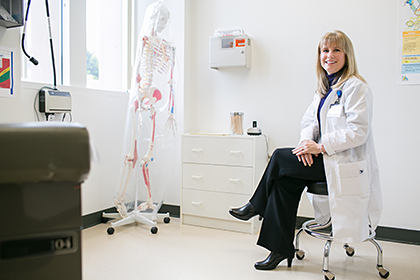AARP Hearing Center

By Rita Beamish
Gratitude is the primary response that nurse practitioners such as Susanne Phillips hear from their patients. The amount of time that nurses spend on patients’ ailments, lifestyle factors and prevention strategies—even making the occasional home visit—can be a refreshing change from the typical revolving-door, perfunctory appointment with a doctor.
“And the second thing [you hear] is, ‘You listen,’ ” said Phillips, an associate clinical professor at the University of California, Irvine, who leads the Family Nurse Practitioner Concentration. “Our education prepares nurses to listen to patients first, and to let them tell you the important information you need to determine what’s going on in their lives.”
Nurse practitioners (NPs) have advanced education and training to provide many aspects of primary care for which people commonly see physicians—diagnostics, ordering tests, managing treatments and prescribing medications. But California and most other states limit their availability by permitting these nurses to practice only with the oversight of a doctor.
That means extra layers of paperwork, supervision and sign-offs when treating Medi-Cal, Medicare and other patients. For some patients, it means longer travel to get primary health care because the NPs who potentially could open a practice in underserved areas instead are tied to existing doctor practices.
California lawmakers and advocates have grappled, so far unsuccessfully, with loosening such restrictions on the state’s more than 18,500 nurse practitioners. The Institute of Medicine recommends that the limits be lifted to give nurses a larger role in health care, and at least 16 states have taken steps to do that.
Shortage of physicians
Under the federal Affordable Care Act, an estimated 5.3 million Californians will be eligible to become insured, putting a strain on an already burdened primary care network. California doesn’t have enough physicians to serve its population, and fewer than a third of residents live in communities that have adequate primary care access, a legislative analysis found.
“We should make sure that the nurse practitioners can use every ounce of their talent for what is needed,” said Susan Reinhard, senior vice president and director of the AARP Public Policy Institute. “Consumers should have a choice of different clinicians who will suit their preferences and their needs.”
Reinhard is also chief strategist for the Center to Champion Nursing in America, a partnership of AARP, AARP Foundation and the Robert Wood Johnson Foundation, aiming to ensure that nurses can practice to the full extent of their training.
The California Medical Association says doctors are more qualified to evaluate and treat patients. And skeptics say there’s no reason to think autonomous NPs would see more patients than those under doctor oversight. But Reinhard pointed to a study showing that many doctor-supervised NPs spend 10 percent of their time on tasks involving supervisory issues, taking time away from patients.
Proponents also cite research showing comparable health care results whether a patient was treated by a doctor or a nurse practitioner. Nurse practitioners, like doctors, still refer patients to medical specialists as appropriate.
Rita Beamish is a writer living in San Mateo, Ca.































































